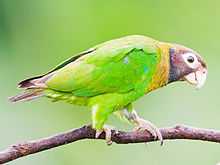Brown-hooded parrot
| Brown-hooded parrot | |
|---|---|
 | |
| Conservation status | |
| Scientific classification | |
| Kingdom: | Animalia |
| Phylum: | Chordata |
| Class: | Aves |
| Order: | Psittaciformes |
| Superfamily: | Psittacoidea |
| Family: | Psittacidae |
| Subfamily: | Arinae |
| Tribe: | Androglossini |
| Genus: | Pyrilia |
| Species: | P. haematotis |
| Binomial name | |
| Pyrilia haematotis (Sclater & Salvin , 1860) | |
| Synonyms | |
|
Pionopsitta haematotis | |
The brown-hooded parrot (Pyrilia haematotis) is a small parrot which is a resident breeding species from southeastern Mexico to north-western Colombia. Until recently, it was placed in the genus Pionopsitta, which now is restricted to the type species, the pileated parrot. It is sometimes considered conspecific with the rose-faced parrot (P. pulchra). This species has been adversely affected by deforestation.
It is found in lowlands and foothills locally up to 1600 m altitude in forest canopy and edges, and adjacent semi-open woodland and second growth. The white eggs are laid in an unlined nest, usually a natural cavity in a tree.
Description
The brown-hooded parrot is 21 cm long and weighs 165 g. The adult has a brown head and neck, darker on the face, especially in males, and a red ear-patch. The rest of the body is mainly green, with an olive tone to the breast. The wings have blue outer primaries and red linings which show well in flight, and the tail has reddish sides The eye-ring and bill are pale. Young birds are similar to the adults, but paler, duller, and without red on the head.
Behaviour
The brown-hooded parrot feeds in pairs or small flocks of up to 15 birds, taking various seeds and fruits, including figs, from trees and epiphytes. It can be difficult to see when feeding since it is slow-moving, usually silent, and keeps in the canopy.
Its flight call is a rolling kereek, and when perched it has a variety of social gurgles and squeaks.
References
- ↑ BirdLife International (2012). "Pyrilia haematotis". IUCN Red List of Threatened Species. Version 2013.2. International Union for Conservation of Nature. Retrieved 26 November 2013.
- Stiles and Skutch, A guide to the birds of Costa Rica ISBN 0-8014-9600-4
- Ribas, C., R. Gaban-Lima, C. Miyaki, and J. Cracraft (2005). Historical biogeography and diversification within the Neotropical parrot genus Pionopsitta (Aves: Psittacidae). Journal Biogeography 32:1409-1427.
